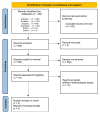Transcutaneous Neuromodulation for Constipation and Fecal Incontinence in Children: A Systematic Review and Meta-Analysis
- PMID: 36836787
- PMCID: PMC9960109
- DOI: 10.3390/life13020430
Transcutaneous Neuromodulation for Constipation and Fecal Incontinence in Children: A Systematic Review and Meta-Analysis
Abstract
Introduction: Constipation is a disorder with a multifactorial origin. Constipation has a varied clinical presentation, including infrequent defecation of bulky stools and episodes of retentive fecal incontinence. Neuromodulation has been used to treat many health problems, with promising results.
Objective: To conduct a systematic review of randomized clinical trials based on the effects of transcutaneous neuromodulation in treating constipation and retentive fecal incontinence in children and adolescents.
Methods: A systematic review of randomized clinical trials was performed. Medline (PubMed), PEDro, SciELO, Cochrane (CENTRAL), Embase, and Scopus databases were searched from March 2000 to August 2022. We included clinical trials evaluating transcutaneous neuromodulation in children with constipation and fecal incontinence compared or associated with other types of treatment. Two reviewers independently selected relevant studies, assessed the methodological quality, and extracted the data.
Results: Three studies with 164 participants were included in this review. Two meta-analyses were generated based on these studies. These analyses revealed that transcutaneous neuromodulation is an effective adjuvant treatment modality that improves children's constipation and retentive fecal incontinence. The methodological quality of the included studies was classified as high based on the assessment of the quality of evidence, with a high degree of confidence based on the GRADE system.
Conclusions: Transcutaneous neuromodulation is an effective adjuvant treatment modality for children with constipation and retentive fecal incontinence.
Keywords: children; constipation; fecal incontinence; neuromodulation.
Conflict of interest statement
The authors declare no conflict of interest.
Figures







Similar articles
-
Current State of Neuromodulation for Constipation and Fecal Incontinence in Children: A Systematic Review.Eur J Pediatr Surg. 2019 Dec;29(6):495-503. doi: 10.1055/s-0038-1677485. Epub 2019 Jan 16. Eur J Pediatr Surg. 2019. PMID: 30650450
-
Cochrane Review: Osmotic and stimulant laxatives for the management of childhood constipation (Review).Evid Based Child Health. 2013 Jan;8(1):57-109. doi: 10.1002/ebch.1893. Evid Based Child Health. 2013. PMID: 23878124 Review.
-
Transanal irrigation is effective in functional fecal incontinence.Eur J Pediatr. 2017 Jun;176(6):731-736. doi: 10.1007/s00431-017-2902-3. Epub 2017 Apr 12. Eur J Pediatr. 2017. PMID: 28401344
-
THE FATIGUE RATE INDEX IS HIGHER IN CHILDREN WITH FUNCTIONAL CONSTIPATION AND RETENTIVE FECAL INCONTINENCE.Arq Gastroenterol. 2022 Jul-Sep;59(3):428-433. doi: 10.1590/S0004-2803.202203000-76. Arq Gastroenterol. 2022. PMID: 36102443
-
Electro-Neuromodulation for Colonic Disorders-Review of Meta-Analyses, Systematic Reviews, and RCTs.Neuromodulation. 2020 Dec;23(8):1061-1081. doi: 10.1111/ner.13099. Epub 2020 Feb 3. Neuromodulation. 2020. PMID: 32017319 Review.
Cited by
-
Clinical Efficacy of Transcutaneous Electrical Nerve Stimulation (TENS) in Pediatric Functional Constipation: Impact on Immunological Indicators and Gut Microbiota.J Immunol Res. 2025 Feb 5;2025:8888730. doi: 10.1155/jimr/8888730. eCollection 2025. J Immunol Res. 2025. PMID: 40027592 Free PMC article.
-
Transcutaneous Posterior Tibial Nerve Stimulation: An Adjuvant Treatment for Intractable Constipation in Children.Biomedicines. 2024 Jan 12;12(1):164. doi: 10.3390/biomedicines12010164. Biomedicines. 2024. PMID: 38255269 Free PMC article.
-
Colonic Electrical Stimulation for Chronic Constipation: A Perspective Review.Biomedicines. 2024 Feb 21;12(3):481. doi: 10.3390/biomedicines12030481. Biomedicines. 2024. PMID: 38540095 Free PMC article. Review.
References
-
- Mousa H.M., Barsamian J.M., Benitez A.J., Webster J.M., Fiorino K.N. Pediatric Constipation: An Epidemiologic and Physiologic Approach to Guide a Stepwise Approach to its Management. Curr. Treat. Options Pediatr. 2020;6:155–169. doi: 10.1007/s40746-020-00199-z. - DOI
-
- Tabbers M., DiLorenzo C., Berger M., Faure C., Langendam M., Nurko S., Staiano A., Vandenplas Y., Benninga M., European Society for Pediatric Gastroenterology et al. Evaluation and treatment of functional constipation in infants and children: Evidence-based recommendations from ESPGHAN and NASPGHAN. J. Pediatr. Gastroenterol. Nutr. 2014;58:258–274. doi: 10.1097/MPG.0000000000000266. - DOI - PubMed
Publication types
LinkOut - more resources
Full Text Sources

